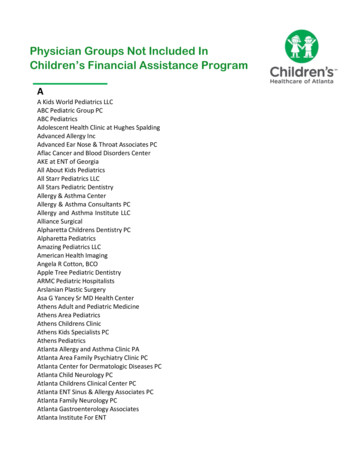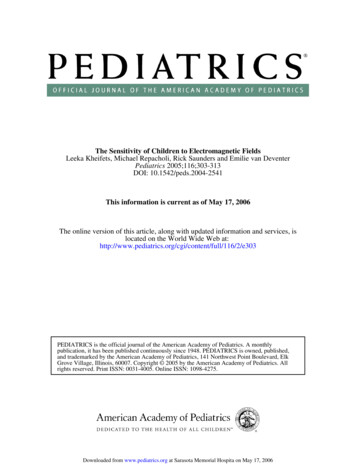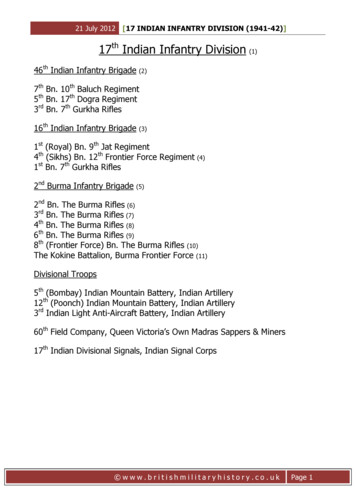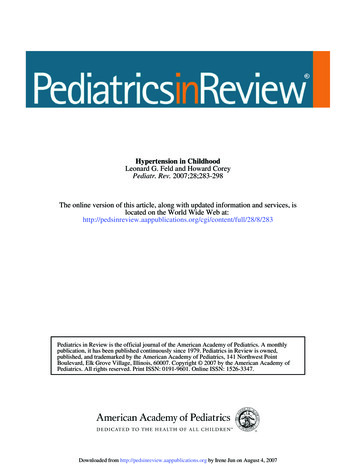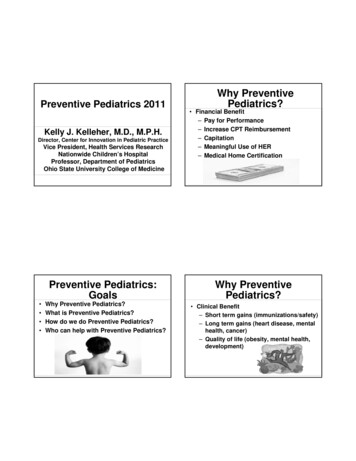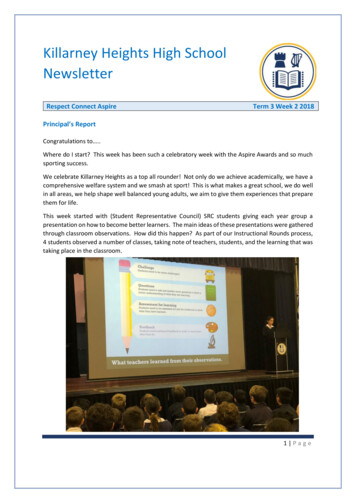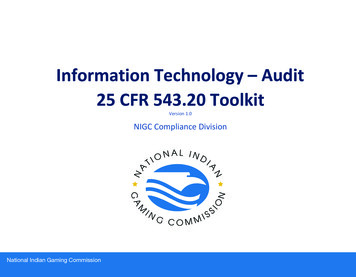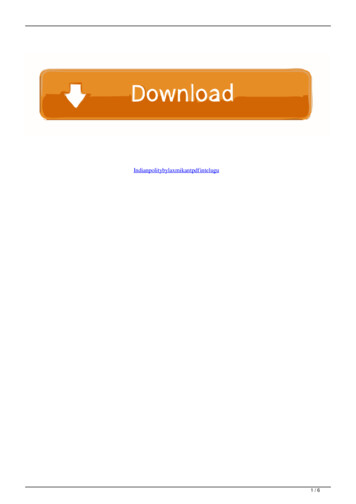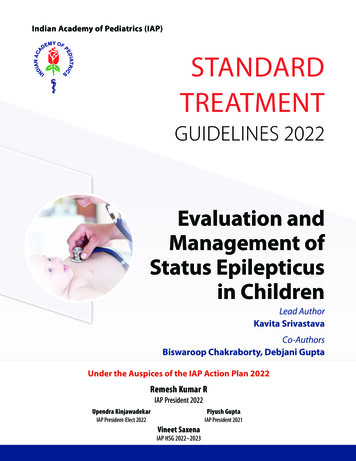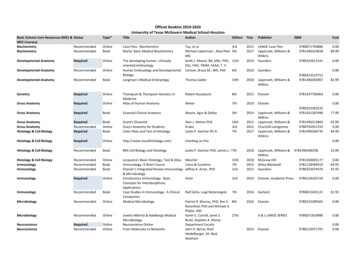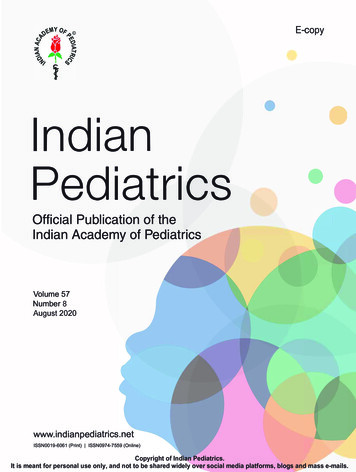
Transcription
E-copyIndianPediatrics Official Publication of theIndian Academy of PediatricsVolume 57Number 8August 2020www.indianpediatrics.netISSN0019-6061 (Print) I ISSN0974-7559 (Online)Copyright of Indian Pediatrics.It is meant for personal use only, and not to be shared widely over social media platforms, blogs and mass e-mails.
ADVERTISEMENTThere's so much to achieve!There's Anti-microbial Activity. · Bacillus subtilis produces 66 antimicrobials*There's Immunomodulation. · Promotes robust development of GALT"*There's Intestinal Homeostasis. · Reduces intestinal inflammation & protectsagainst cell injury*.and there's More to achieve with. - - - - - - - - - - - - - - . \1-ed F,11,;;t-.',ca. .,.,. ":.6.2. --o 1:1."Ill19}a. iilllll'\'I'. GUTPRo·In Dian-hea and Antibiotic Associated Dian-hea JO mlProbioticLiquidSYRUP /acikJs stiJ/ls lHU58) 2 Biioo spores"'' dose·. -,,:;,'pedMoreDosage:5ml '2 times a day"' : --------- - ,.,. (N,Bacillus subtilis has GRAS status from USFDA' &Qualified Presumption of safety from EFSA'J. B. CHEMICALS & PHARMACEUTICALS LIMITED., GALT Gut Associated lymphoid Tissue USFOA United States Food & Drugs Association EFSA European Food Safety Authority Adapted from : Suva MA, Sureja VP, Kheni OB. Curr Res Sci Med 2016;2:65-72. Gutpro is Registered Trademark of J B Chemicals & Pharmaceuticals Limitedo HU58 is traclemark. of Synergia Life Sciences PvL ltd., under license from Royal Holloway, University of LondonCnergy IT Park, Unit A2., 3rd Floor, Unit A, 8th Floor,Appa Saheb Marathe Marg, Prabhadevi, Mumbai 400 025.Website: www.jbcpl.com for maintaining a healthy intestinal microbiolaINDIAN PEDIATRICS699VOLUME57-AUGUST 15,2020
ADVERTISEMENTA Natural & Safe way to preventInfantile Colic & symptoms of Lactose Intolerance@YAMOO Dr psLactase enzyme 600 FCC units------- ------For the Natural and Safe management of Lactose Intolerancein Children and AdolescentsV AM .OO@ChewableTabletsLactase enzyme 4500 FCC unitsINDIAN PEDIATRICS700VOLUME57-AUGUST 15,2020
IndianPediatricsAugust 2020Editor-in-ChiefExecutive EditorManaging EditorAssociate EditorsDevendra MishraSiddarth RamjiRakesh LodhaAnup MohtaPooja DewanSharmila B MukherjeeJoseph L MathewAashima DabasExecutive MembersAbhijit SahaJS KaushikSunita BijarniaRachna SethSomshekhar NimbalkarSanjay VermaKirtisudha MishraNidhi BediAshish JainKana Ram JatSumaira KhalilRomit SaxenaInternational Advisory BoardPrashant Mahajan (USA)Sanjay Mahant (Canada)PSN Menon (Kuwait)John M Pettifor (South Africa)SudhinThayyil (UK)Gaurishankar Shah (Nepal)National Advisory BoardCentral ZoneGouri PassiPawan Kalyan PinnamaneniEast ZoneSudip DuttaApurba GhoshNorth ZoneSourabh DuttaRaj Kumar GuptaSouth ZoneSubramanya NKRajeev K ZachariahWest ZoneMahesh A MohiteParesh ThakkerChief AdvisorAP DubeyCentral IAP AdvisorsBakul J ParekhPiyush GuptaS ThangaveluGV Basavaraj (Ex-officio)BiostatisticsAmir Maroof KhanRajeev MalhotraElectronic MediaSanjeev GoelEthicsArun GuptaOffice MattersPeeyush JainChandramohan KumarPublicationAS VasudevSangitaYadavSocial MediaDinesh MittalJerin C ShekharWebsiteC VidyashankarAmit P ShahVolume 57Number 8CONTENTSPRESIDENT’S PAGEAcademic Leadership for the Next Decade–BAKUL JAYANT PAREKH703EDITORIAL COMMENTARYHigher Physical Activity Levels in Children Have Wide Ranging Benefits:705Towards Multisectoral Action–SHIFALIKA GOENKA AND RAJI DEVARAJANRESEARCH PAPERSReliability and Validity of a Physical Activity Questionnaire for IndianChildren and Adolescents–TS MEHREEN, HARISH RANJANI , C ANITHA ,N JAGANNATHAN , MICHAEL PRATT, VISWANATHAN MOHAN ANDRANJIT MOHAN ANJANA707Intake of Ultra-processed Foods Among Adolescents From Low- andMiddle-Income Families in Delhi–A JAIN AND P MATHUR712Serum Presepsin, Proadrenomedullin andTriggering Receptor Expressedon Myeloid Cells-1 (TREM-1) as Biomarkers for the Diagnosis of AcutePyelonephritis–NURAN CETIN, ZEYNEP KUSKU KIRAZ AND AYLIN GENCLER715Assessment of Autonomic Nervous System in Children with CeliacDisease: A Heart Rate Variability Study–SEYMA KAYALI AND SUNA SELBUZ 719RECOMMENDATIONSGuidelines on Diagnosis and Management of Cow’s Milk Protein Allergy–JOHN MATTHAI, MALATHI SATHIASEKHARAN, UJJAL PODDAR, ANUPAM SIBAL,ANSHU SRIVASTAVA, YOGESH WAIKAR, ROHAN MALIK, GAUTAM RAY, S GEETHAAND SK YACHHA FOR THE INDIAN SOCIETY OF PEDIATRIC GASTROENTEROLOGY,HEPATOLOGY AND NUTRITION; PEDIATRIC GASTROENTEROLOGY CHAPTER OFINDIAN ACADEMY OF PEDIATRICS724SPECIAL ARTICLEEnsuring Exclusive Human Milk Diet for All Babies in COVID-19 Times–RUCHIKA CHUGH SACHDEVA, SUKSHAM JAIN, SUCHANDRA MUKHERJEE730AND JAI SINGHRATIONAL DIAGNOSTICSLiver Biopsy in Children–TEBYAN RABBANI, JOHANNA M ASCHER BARTLETT734AND NAVEEN MITTALREMINISCENCES FROM INDIAN PEDIATRICS: A TALE OF 50YEARSDuchenne Muscular Dystrophy: Journey from Histochemistry toMolecular Diagnosis–JAYA SHANKAR KAUSHIK AND SATINDER ANEJA741701
CONTENTS (contd.)UPDATESGuidelines on Hemolytic Uremic Syndrome by Indian Society of Pediatric Nephrology: Key Messages–PRIYANKA KHANDELWAL AND ARVIND BAGGA744IN A LIGHTER VEINIn the Darker Vein: Being a Pediatric Oncologist– AJEITHA LOGANATHAN748RESEARCH LETTEROnline Survey of Vitamin D Supplementation Practices in Children and Adolescents–AASHIMA DABAS,MADHAVI BHARADWAJ, DHEERAJ SHAH AND PIYUSH GUPTA749Celiac Disease in Indian Children and Adolescents with Type 1 Diabetes–N AGARWAL, C DAVE, R PATEL,R SHUKLA AND A BAJPAI750CLINICAL CASE LETTERSNovel Coronavirus Mimicking Kawasaki Disease in an Infant–BHASWATI C ACHARYYA,SAUMYABRATA ACHARYYA AND DHRITABRATA DAS753Portal Hypertension in a Case of Klippel Trenaunay Syndrome–HASEENA SAIT, PUNEET KAUR SAHI ANDSEEMA KAPOOR754Acute Transient Pancreatitis Associated With Milk Allergy in an Infant–YUKIKO INADA, TAKUJI NAKAMURAAND MASAFUMI ZAITSU756Duodenal Web with Trichobezoar: An Unusual Presentation–VIVEK MANCHANDA, SHEKHAR BISWAS,ANIRUDH GHAI AND SANJAY GOYAL757CASPR2-Mediated Autoimmune Encephalitis in a Toddler–BALAMURUGAN NAGARAJAN, VYKUNTARAJUK GOWDA, SANJAY KSHIVAPPA AND ANITA MAHADEVAN757Subtle Clinical Presentation of Pulmonary Alveolar Microlithiasis–D VIJAYASEKARAN, AYESHA SHAHNAZ,C SATHEESH AND HIMA BINDU VIPPARTHI759Plastic Bronchitis: A M anifestation of Dander Hypersensitivity–RITIKA CHHAWCHHARIA, NEERAJ GUPTA,DHIREN GUPTA AND POOJAN AGARWAL760Diabetic Striatopathy in a Child: A Cause of Reversible Chorea–HR PUNEETH, PREETI KULHALLI,AND VINOD H RATAGERI761Transient Elastography to Represent Hepatic Copper Accumulation in Wilson Disease–JIRAKORN JAMRASNARADOM AND PALITTIYA SINTUSEK762Steroid Resistant Nephrotic Syndrome with Clumsy Gait Associated With INF2 Mutation–RAJIV SINHA, RANIT MAITI, DEBADITYA DAS AND KAUSIK MANDAL764Hyperuricemia and Early-onset Chronic Kidney Disease in a 7-year-old Child–DESPOINA TRAMMA AND DESPOINA SAMOURKASIDOU765CORRESPONDENCE766NEWS IN ,722,743,752,783-84Address for ordinary letters: The Editor-in-Chief, Indian Pediatrics, P. Box No. 3889, New Delhi-110 049.Address for registered/speed post letters: Dr. Devendra Mishra, Editor-in-Chief, Indian Pediatrics,115/4, Ground Floor, Gautam Nagar, New Delhi 110 049, India. Tel: (011) 46052593E-mail: jiap@nic.in; Website: www.indianpediatrics.net; Facebook: www.facebook.com/Indianpediatrics;Twitter: @EditorIndPed; Instagram: @indianpediatrics702
PRESIDENTS PAGEAcademic Leadership for the Next DecadeBAKUL JAYANT PAREKHPresident, Indian Academy of Pediatrics 2020bakulparekh55@gmail.comDear IAPians, It gives me great pleasure towrite to you about one of the most criticalacademic initiatives embarked upon by yourAcademy.You may access the education services onwww.diapindia.org on your computer or using yourmobile phone browser.In this context, it gives me great pleasure to announcethat IAP shall soon make the Indian College of Pediatrics(ICP) a reality. The Indian College of Pediatrics, an initiativeby our Past President Dr CP Bansal in 2013, shall comealive next year and transform our academic activities. ICPwill be a leading global university for pediatrics, spanningonline, offline and hybrid education. I am confident thatICP will accelerate its launch and growth by leveraging thecapabilities built by dIAP.As the COVID-19 crisis has made us painfully aware,without connectivity and technology, it is impossible tofunction effectively in a locked-down world.Even without this wake-up call, the whole worldwould agree that the Academy, just like all otherorganizations anywhere in the world, will transform into aDigital Academy. Organizations that do not have anunderlying digital infrastructure with cutting edgecapabilities will become increasingly ineffective andirrelevant, and fail to survive in the future.MORE ABOUT DCOEThe online certificate courses and testing services of theDCOE already have over 150 professionally recorded andedited lectures by IAP experts, and an additional 200 areunder production. The lectures will cover all pediatricsareas and organized into over a hundred courses/modules. The best part about these modules is that theycan not only be used for online education, but also by allour local chapters as standardized education material forlocal IAP experts to conduct physical classroomsessions and hybrid sessions. The recording,professional editing, and publishing are done free of costby dIAP for all subspecialty chapters.IAPs own highly successful digital education effortsin the recent past, have made us aware of the immensepossibilities and vastly enhanced capabilities thattechnology offers to an academic body like IAP.No longer do we need to have any barriers of distanceor cost to creating and disseminating education. We canalso enhance the scope of our education to cover textmaterial, lectures, panel discussions, workshops, casestudy discussions, and online clinics for doctors. We canconduct academic training from anywhere and access itfrom anywhere.The online interactive education platform of theDCOE has already conducted over 250 national events inthe last three months. This capability is now being madeavailable to all regional, state, and local chapters of IAPto hold online events for their members. For all educationevents, dIAP enables industry sponsorships. For thoseevents where dIAP is unable to obtain grants orsponsors, dIAP is giving a full subsidy and conductingthe events free of cost for the chapters.All our academic administration shall be made easyby our technology, whether it be registrations,payments, member services, local chapter websites,activities announcements, event calendars, and more.Under the dIAP program, IAP has focused onbuilding the end-to-end digital capabilities that a largescale teaching institute would require. We are nowmaking the services available as a Digital Center ofExcellence (DCOE), accessible on dIAP. The DCOEalready includes online certificate courses with testing,an online interactive education platform, and an onlinereference library of text material and videos. DCOE isavailable to all IAP members and students of pediatrics.INDIAN PEDIATRICSThe online reference library of DCOE has asearchable archive of over 400 educational videos. Andmany shall include expert advice forums for IAPmembers.703VOLUME 57 AUGUST 15, 2020
PRESIDENT’S PAGEINDIAN COLLEGE OF PEDIATRICSfull-fledged online university at no additional expense.The ICP is being revived, architected, and built as asignificant initiative for launch in 2021. The ICP shall bean integral part of the Indian Academy of Pediatrics andserve as the highest academic wing of IAP.The DCOE shall itself be under the academicgovernance of the Indian College of Pediatrics. TheIndian College of Pediatrics shall surely be the mostcomprehensive and large scale pediatrics universityanywhere. Your Academy now has the capability to makethis a reality, well before December, 2021.Jai Hind!Jai IAP!DCOE capabilities shall accelerate the production andpublishing of academic content for ICP. ICP will alsoacquire the administration and teaching capabilities of aNOTICEResearch papers are invited in the following categories ofAwards for the year 2021Award rules may be obtained from the Central Office on request and are also available df(The papers not submitted as per award rules will be rejected.)Dr. James Flett Endowment Award (Two Prizes) for the best papers on “Social & Preventive Pediatrics”.Dr. ST Achar Endowment Award (One Prize) for the best paper on “Pediatrics”.Dr. SS Manchanda Neonatology Research Award (One Prize) for the best paper on “Neonatology”.Dr. V Balagopal Raju Endowment Award (Two Prizes) for the best papers on “Child Health”.Instructions:1. The hard copy of the ABSTRACT as well as the FULL paper in 4 (FOUR COPIES) should be submittedto Hon. Secretary General, Indian Academy of Pediatrics, Kamdhenu Business Bay, 5th Floor, PlotNo. 51, Sector 1, Juinagar (Near Juinagar Railway Station), Nerul, Navi Mumbai – 400706, India,along with the declaration certificate as prescribed in the award rules.2. The ABSTRACT should not be more than 300 words.3. The FULL award paper should be in the style of Research Papers published in Indian Pediatrics. Seeinstructions for authors at www.indianpediatrics.net for details.4. The title of the paper should be brief but adequately descriptive.5. The text of the Abstract should be structured as per author instructions of Indian Pediatrics.6. The papers not accepted for award competition will not be presented in any other category.The last date for submission of award papers at the Central IAP Office (Hard Copy) is 30 September,2020.Presentation of papers:Authors of the papers that have been accepted for presentation will be asked to present them at asuitable platform in early 2021. Authors will be informed of the venue and modality for the same.Email: centraloffice@iapindia.org Website: www.iapindia.orgINDIAN PEDIATRICS704VOLUME 57 AUGUST 15, 2020
EDITORIAL COMMENTARYHigher Physical Activity Levels in Children Have Wide Ranging Benefits:Towards Multisectoral ActionSHIFALIKA GOENKA1,2* AND RAJI DEVARAJAN11Centre for Chronic Disease Control, New Delhi, India; 2Public Health Foundation of India, Gurugram, Haryana, India.shifalika.goenka@phfi.orgIn this issue of Indian Pediatrics, Mehreen, et al. [1]elicit the validity and reliability of a tool for selfreported physical activity measurement in Indianchildren and adolescents 10-17 years of age. Thecorrelation coefficients (95% CI) for sedentary behaviourand moderate to vigorous physical activity for ModifiedPhysical Activity Questionnaire for Children,[MPAQ(c)], against accelerometer were 0.52 (0.36, 0.64)and 0.41 (0.23, 0.55), respectively, indicating moderatecorrelation. This is typical of self-reported physicalactivity tools globally. Self-reported physical activityremains the main stay for population-based studies, dueto its low cost and practicality.hours. Screen time needs to be minimal, if at all, and at themost limited to 2 hours a day [2-5].Globally, more than 80% (85% girls and 78% boys) ofschool-going adolescents, aged 11-17 years, do not meetthe current recommendations of at least one hour ofphysical activity per day. In India, 73.9% (71.8% boysand 76 % girls) of the school going children did not meetthe minimum recommended moderate or vigorousphysical activity of 60 minutes per day [6]. Inactivity inthese school-going adolescents was jeopardizing theirpresent and future health.“How can we get more children to be more physicallyactive?” is the key public health question. Physicalactivity should be the most convenient, desirable, safeactivity which should be performed during school hours,at home for recreation, and even during daily commute.In the context of the Covid-19 pandemic, open activetransport and recreation has taken further precedence. InEurope, huge financial resources have been allocated tofurther widen the already wide side-walks, and cyclinglanes, narrowing motor carriageways to half. Physicalactivity should be part of an essential foundation ofgrowing up. According to the WHO’s Global Action Planon Physical Activity 2018-2030, we need to create activesocieties, active environments, active people and activesystems [7]. Creating ‘active people’ requires access toprospects, across myriad settings, to help people of allages to indulge in regular physical activity as individuals,families and communities. Creating ‘active systems’requires implementation of effective synchronizednational and subnational action to increase physicalactivity and reduce sedentary behaviour [7]. Effectivegovernance, leadership, and multisectoral partnershipsand advocacy, across all pertinent sectors is the key.Creating ‘active environments’ requires the establishmentand protection of surroundings that promote physicalactivity in all forms and safeguard the dignity and rightsof all people, of all ages, and backgrounds [7,8].The benefits of physical activity are wide-ranging,enormous and lifelong. Also, behaviors etched inchildhood set the foundation for adult behaviors. Strongscientific evidence demonstrates that higher amounts ofphysical activity are associated with increased cardiorespiratory and muscular fitness, improved bone health,cardiometabolic health, academic outcomes, bettercognitive development (executive function, attention,memory, crystalized intelligence, processing speed),fewer symptoms of depression, and reduced risk ofadiposity in children aged 3 to 17 years [2-5].The World Health Organisation (WHO) and theCentres for Disease Control and Prevention (CDC)recommend that children and adolescents should indulgein 60 minutes of moderate to vigorous aerobic activitylike running or swimming for a minimum of an hour eachday. In addition, bone and muscle strengthening activitiesshould be indulged in atleast three days a week. Bonestrengthening activities are those which create an impactwith gravity signalling the brain towards greater bonestrength. Examples are: skipping, jumping, basketball,etc. Muscle strengthening activities include climbingstairs, climbing trees, dancing etc. Every day, severalhours of active play is recommended. In addition, it isrecommended that children be encouraged towards activetransport to school and several hours of play after schoolINDIAN PEDIATRICSUrban forests/large green lush public parks within705VOLUME 57 AUGUST 15, 2020
EDITORIAL0.4-0.5 km radius ( 0.5 Ha) of every family, significantlyincreases physical activity (68-89 minutes or more) [9].Wide sidewalks as wide as the roads are recommendedand so are limiting motor carriageways. Ability to walksafely and pleasurably to school and parks are critical andso are play grounds, and other sporting facilities inschools. Air-pollution should not act as a deterrent tophysical activity as the benefits from physical activityoutweigh the risks of air pollution [10]. Lush green treeson either side of the road, in schools and in parks not onlyreduces the ambient temperature, but they also reduce theparticulate matter and air-pollution [11]. A ‘dashboard’ ofmonitoring and accountability indicators, applicable tothe Indian context, pertaining to safety, the environmentalfactors, accessibility and comfort of physical activityduring daily living is required [12].3.4.5.6.The Draft National Education Policy (2019) has givenan emphasis on incorporating physical education andsports into the curriculum, starting in early school. TheNational Multi-sectoral Action Plan (NMAP) forprevention and control of common NCDs (2017-2022) inIndia has placed high importance for promoting physicalactivity [13]. Khelo India program has been launched bythe Ministry of Sports [14]. The ‘Fit India’ movement wasalso launched in August, 2019. Dr. Fiona Bull, leading theDivision of Physical activity at WHO says “Young peoplehave the right to play and should be provided with theopportunities to realise their right to physical and mentalhealth and well being.”7.8.9.10.To conclude, ‘active children’ require active schools,active roads, active policies, active communities, activeurban design and active recreation. These will lead to aprogressive, equitable, environmentally sensitive andactive India.11.12.Funding: SG is partially sponsored by Wellcome Trust Grants(2/8/92/Z/ and 203/24/Z/16/Z) and supported part time by theCentre for Chronic Disease Control. Conflict of interest: Nonestated.13.REFERENCES1. Mehreen TS, Ranjani H, Anitha C, Jagannathan N, PrattM, Mohan V, et al. Reliability and Validity of a PhysicalActivity Questionnaire for Indian Children andAdolescents. Indian Pediatr. 2020;57:707-11.2. World Health Organisation. Public consultation on theINDIAN PEDIATRICS14.706draft WHO Guidelines on physical activity and sedentarybehaviour for children and adolescents, adults and olderadults 2020 2020. Available from: and-adolescents-adults-andolder-adults-2020. Accessed on 17 July, 2020.2018 Physical Activity Guidelines Advisory CommitteeScientific Report. Washington, DC: U.S. Department ofHealth and Human Services, 2018.Australian Institute of Health Welfare. Australia’schildren 2020. Available from: . Accessed on 17 July, 2020.US Department of Health and Human Services. PhysicalActivity Guidelines for Americans, 2nd Edition. 2019.Guthold R, Stevens GA, Riley LM, Bull FC. Global trendsin insufficient physical activity among adolescents: apooled analysis of 298 population-based surveys with 1.6million participants. Lancet Child Adolesc Health.2020;4:23-35.World Health Organisation. Global action plan onphysical activity 2018-2030. Geneva, 2018.Heath GW, Parra DC, Sarmiento OL, Andersen LB, OwenN, Goenka S, et al. Evidence-based intervention inphysical activity: lessons from around the world. Lancet.2012;380:272-81.Sallis JF, Cerin E, Conway TL, Adams MA, Frank LD,Pratt M, et al. Physical activity in relation to urbanenvironments in 14 cities worldwide: a cross-sectionalstudy. Lancet. 2016;387:2207-17.Sun S, Cao W, Qiu H, Ran J, Lin H, Shen C, et al. Benefitsof physical activity not affected by air pollution: aprospective cohort study. Int J Epidemiol. 2020;49:142-52.Vailshery L, Jaganmohan M, Nagendra H. Effect of streettrees on microclimate and air pollution in a tropical city.Urban Forestry and Urban Greening. 2013;12:408-15.Devarajan R, Prabhakaran D, Goenka S. Builtenvironment for physical activity-An urban barometer,surveillance, and monitoring. Obes Rev. 2020;21:e12938.Ministry of Health and Family Welfare GoI. NationalMultisectoral Action Plan for Prevention and Control ofcommon NCDs (2017-2022) 2017. Available on%20NCDs%20%282017-22%29 1.pdf. Accessedon 17 July, 2020.Ministry of Youth Affairs and Sports GoI. Khelo India2018. Available from: https://kheloindia.gov.in/about.Accessed on 17 July, 2020.VOLUME 57 AUGUST 15, 2020
RESEARCHPAPERReliability and Validity of a Physical Activity Questionnaire for IndianChildren and AdolescentsTS MEHREEN1, HARISH RANJANI 1, C ANITHA 1, N JAGANNATHAN 1, MICHAEL PRATT2, VISWANATHAN MOHAN 1 ANDRANJIT MOHAN ANJANA 1From 1Madras Diabetes Research Foundation and Dr. Mohan’s Diabetes Specialities Centre, Chennai, Tamil Nadu, India; and2Hubert Department of Global Health, Rollins School of Public Health, Emory University, Atlanta, Georgia, United States.Correspondence to: Dr RM Anjana, Managing Director and Consultant Diabetologist, Dr Mohan’s Diabetes Specialities Centre,WHO Collaborating Centre for Non-Communicable Diseases Prevention and Control, IDF Centre for Education and ICMRAdvanced Centre for Genomics of Diabetes, No. 6B, Conran Smith Road, Gopalapuram, Chennai, India. dranjana@drmohans.coSubmitted: April 08, 2019; Initial review: July 29, 2019; Accepted: March 11, 2020.Background: In low- and middle-income countries, sedentarybehavior is widely prevalent in the young. Reliable and validinstruments are essential for evaluating sedentary behavior andphysical activity in children and adolescents.November and December, 2017. Reliability of MPAQ wasassessed by repeat administration after 2 weeks for upto amonth later. Validity of MPAQ(c) was measured againstaccelerometer using Spearman’s correlation and Bland andAltman agreements.Objective: To evaluate the reliability and validity of an easy touse physical activity questionnaire for children and adolescentsfrom India.Results: Test-retest reliability of the questionnaire revealedgood agreement (ICC: 0.77 min/wk). Correlation coefficients(95% CI) for sedentary behavior and moderate to vigorousphysical activity for MPAQ(c) against accelerometer were 0.52(0.36, 0.64) and 0.41 (0.23, 0.55), respectively indicatingmoderate correlation. Good agreement was present betweenMPAQ(c) and accelerometer for sedentary behavior [mean bias -4.9 ( 2SD -197.1 to 187.3) min/d].Study design: Evaluation of a questionnaire tool.Participants: 104 children and adolescents belonging to theage group of 10-17 years were selected using a purposivesampling technique.Methods: The Madras Diabetes Research Foundation - PhysicalActivity Questionnaire for Children and Adolescents [MPAQ(c)]was used to assess the various dimensions of physical activity.Physical activity was also objectively assessed usingaccelerometer worn around the waist for five complete days.The baseline administration of MPAQ(c) was done betweenConclusion: MPAQ(c) is a valid and reliable instrument forevaluating physical activity in Indian children aged 10-17 years.Keywords: Accelerometry, Assessment, Obesity, Sedentary,Self-reported.Published online: June 12, 2020; PII: S097475591600195Physical activity (PA) is defined as any bodilymovement produced by skeletal muscles thatresults in energy expenditure [1]. Approximately38% of children in India between the ages of 13 to15 years meet the recommended PA levels [2]. Reliable andvalid instruments for evaluating PA in children are essentialfor monitoring and surveillance of PA levels in thepopulation [3]. Objective tools like accelerometers quantifytotal PA well and are easy to use [4]. However, the use ofaccelerometers in large surveillance studies may be limiteddue to time and cost considerations [5,6].questionnaire called the Madras Diabetes ResearchFoundation – Physical Activity Questionnaire for Childrenand Adolescents [MPAQ(c)], which would be acceptableand easy to use for surveillance studies on children andadolescents aged 10 to 17 years in a developing countrylike India. The objective of research reported in this paperwas to evaluate the reliability and validity of thisquestionnaire against objectively collected accelerometerdata.Accompanying Commentary: Pages 705-06.METHODSA questionnaire as an assessment tool is acceptable,easy, practical and feasible for analyzing PA in children andadolescents in a developing country like India. PAquestionnaires help gather qualitative information aboutthe type, location and circumstances of activity that theindividual engages in [7]. Hence, we developed a PAINDIAN PEDIATRICSChildren and adolescents belonging to the age group of 1017 years from Chennai, Tamil Nadu, India were recruited.Participants were selected from 74 areas across the 15 zonesof urban and rural areas of Chennai. Heterogeneity of thesampling framework was maintained throughout the re707VOLUME 57 AUGUST 15, 2020
MEHREEN, ET AL.INDIAN PHYSICAL ACTIVITY QUESTIONNAIREcruitment procedure by randomly recruiting participantsfrom schools, and known households in the selected areasby door-to-door recruitment. A purposive sampling technique was used to select equal number of boys and girlsacross two age groups (10 to 14 and 15 to 17 years). For allparticipants, written informed consent from parents withthe assent from the child were obtained before the start ofthe study. The Institutional Ethics Committee at MadrasDiabetes Research Foundation approved the study protocol.device was allowed to be removed while bathing, swimmingand sleeping. Moderate to vigorous physical activity wasobjectively assessed using the Actigraph (Actilife 5)GT3X Triaxial Accelerometer (Actigraph, Pensacola,Florida, USA) [10,11]. The device was worn on the hip ofthe dominant side (right in most cases). The accelerometerswere initialized to monitor and record data in 60-second‘epochs’ as ‘activity counts’ and sample frequency at 100Hz. While initializing, each device was given a unique number denoting the individual participant with their age, gender, height, weight, date of birth and race. The GT3X device collects data from all three axis of movement regardlessof the configuration, with Axis 1 collecting the vertical axisacceleration activity data, Axis 2 the horizontal axis dataand Axis 3 the perpendicular axis data.Anthropometric measurements and blood pressurewere recorded using standard techniques. Height wasmeasured using a stadiometer (SECA Model 213, SecaGmbh Co, Hamburg, Germany) to the nearest 0.1cm. Weightwas measured using a digital weighing scale (Tanita BC –601, Tanita Corp., Japan) and recorded to the nearest 0.1 kg.Body mass index (BMI) was calculated as per standardformula. Waist circumference was measured in centimetresusing a non-stretchable fiber measuring tape. Bloodpressure and pulse was recorded in a rested sitting position in the right arm using a digital machine (Omron Corp.,Tokyo, Japan) and rounded off to the nearest 2 mm Hg.The baseline administration of MPAQ(c) was donebetween November and December, 2017. This was followedby a repeat administration after 2 weeks (average of 2-4weeks) for upto a month later for assessing reliability.For assessing relative
CONTENTS (contd.) 702 Address for ordinary letters: The Editor-in-Chief, Indian Pediatrics, P. Box No. 3889, New Delhi-110 049. Address for registered/speed post letters: Dr. Devendra Mishra, Editor-in-Chief, Indian Pediatrics, 115/4, Ground Floor, Gautam Nagar, New Delhi 110 049, India. Tel: (011) 46052593
